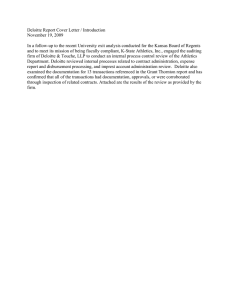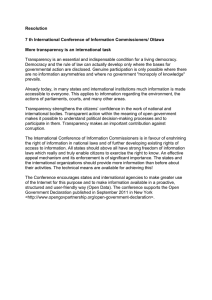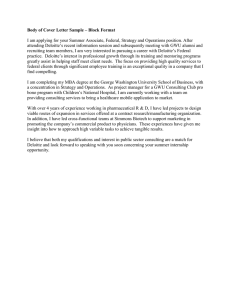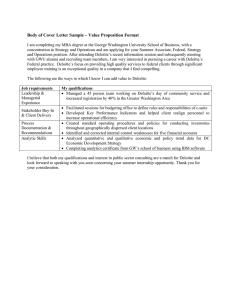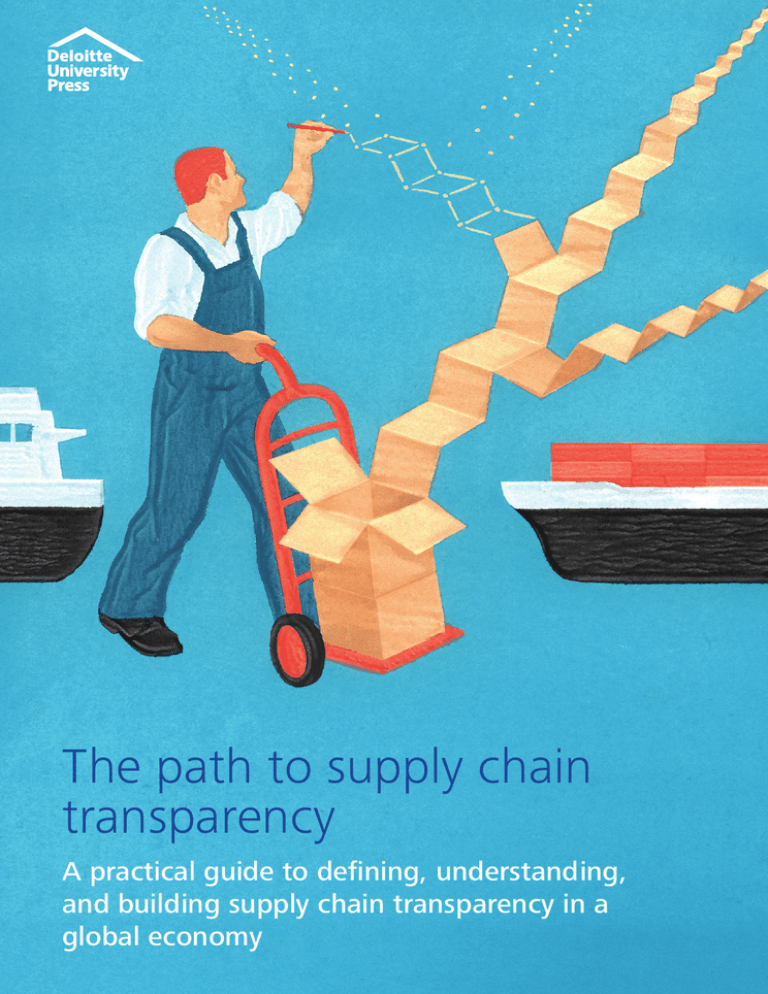
The path to supply chain
transparency
A practical guide to defining, understanding,
and building supply chain transparency in a
global economy
The path to supply chain transparency
About the author
David Linich
David Linich is a principal in Deloitte Consulting LLP’s Strategy & Operations practice. He leads
the organization’s supply chain sustainability services and works with companies to reduce costs,
mitigate risk, and grow revenue from sustainability and resource efficiency efforts. Linich also has
responsibility for the organization’s process intelligence services, where he uses advanced process
improvement techniques to help his clients dramatically reduce process complexity and improve
speed and quality.
Acknowledgements
Special thanks to Lily Russell, Noora Singh, Erik Kiewiet de Jonge, Jared Sheehan, Matt
Pundmann, and Marley Waldman, all of Deloitte Consulting LLP, for their contributions to
this article.
A practical guide to defining, understanding, and building supply chain transparency in a global economy
Contents
Introduction | 2
Why transparency is an imperative | 3
A four-step process for building transparency | 4
The critical role of technology | 10
A clear path to transparency | 12
Endnotes | 13
1
The path to supply chain transparency
Introduction
I
N 1904, Upton Sinclair spent two months in
Chicago’s “Packingtown” uncovering horrific
details about the meat-packing industry, which
he portrayed in the classic book The Jungle.
Public outrage over The Jungle prompted two
new laws—the Food and Drug Act1 and the
Meat Inspection Act2—that became early
drivers of supply chain transparency in the
United States.
More than a century later, companies
continue to face scrutiny of their supply chain
practices, including workers’ rights, product safety and integrity, and environmental
responsibility. Evidence of this scrutiny in
recent years is visible through a number of
high-profile global events. Brands have been
exposed. Coalitions have formed. And more
stringent laws have been passed.3
Yet many companies struggle to achieve
supply chain transparency. A recent study
conducted at Stanford’s Graduate School of
Business revealed that while most respondent
2
companies have social and environmental
systems in place for internal operations, less
than a third have similar structures to monitor
the practices of their immediate and extended
supplier network.4
The dispersed nature of today’s supply
chains creates increasing levels of risk for
multinational businesses, making transparency
both critical and complex. Without effective
visibility into their supply chains, executives
potentially have a significant blind spot in their
enterprise risk management structure, from
which substantial legal, financial, and reputational exposure could emerge.
Supply chain transparency isn’t easily
achieved; it requires a solid foundation and
continuous improvement over time. This
article presents a practical four-step approach
that companies can take to begin the process
of building a transparent supply chain in the
current global environment.
A practical guide to defining, understanding, and building supply chain transparency in a global economy
Why transparency is
an imperative
Transparency goes beyond gaining visibility into the
extended supply chain. It is the process by which
a company takes action on the insights gained
through greater visibility in order to manage risks
more effectively.
I
N the past, considerable physical and temporal distance separated a supply chain’s
upstream activities from the manufacturer
and its downstream stakeholders. Now, the
proliferation of technology, especially mobile
devices, and the pervasive use of social media
have brought upstream risks much closer
to the eyes, ears, and voices of downstream
stakeholders, including consumers, business
customers, news media, regulatory agencies,
and nongovernmental organizations.
At the same time, supply chain risks grow
significantly as supply chains span more
legal jurisdictions, different types of business
practices, and widely varying cultural norms.
In this context, transparency becomes the vital
process of managing risks by accessing, learning from, and acting on supply chain information. By itself, transparency is an increasingly
important capability for companies. But as
part of a company’s broader attempts to build
supply chain resilience—the ability to recover
from and reduce the impact of key risk events5
—transparency’s role is pivotal.
3
The path to supply chain transparency
A four-step process for
building transparency
E
VEN supply chain executives who understand the importance of transparency
may struggle to prioritize activities and build
a transparency process. For companies with
traditional or non-traditional supply chains
(see sidebar, “Risk and transparency in a nontraditional supply chain”), creating a high-level
road map may help. A company can begin
by identifying, prioritizing, and visualizing
potential supply chain risks; then, it can use
“transparency levers” to bridge information
gaps; finally, it can move on to managing the
insights gained from the process and monitoring the supply chain for additional insights
going forward.
RISK AND TRANSPARENCY IN A NON-TRADITIONAL SUPPLY CHAIN
A major hotel company, home to several brands and thousands of properties around the world, was concerned about
potential supply chain vulnerabilities. Yet executives were unsure about how to prioritize areas requiring improved
transparency. The company followed a four-step process to transparency:
• Identifying and prioritizing risks. Given the company’s global presence and the nature of the hospitality industry, the
transparency team prioritized two sets of risks—one by product category (for example, food, beverages, and linens)
and the other by overall risk within the supply chain organization (for example, monitoring adherence to policies and
combating fraud).6
• Visualizing risks. Because the company was concerned about product category and cross-product category
supply chain risks, the transparency team chose to map the organization’s broader supply chain before drilling into
individual product categories. After mapping key players and information gaps, the procurement team emerged as an
important gatekeeper that could build added visibility and flag risks within the company’s supply base. Effectively, the
procurement team became the critical node to manage both product category risks and supply chain risks.
• Using transparency levers to close information gaps. Focusing on the central procurement organization, the
transparency team refined criteria and processes relating to supplier due diligence and ongoing assessments. The
company already followed a supplier due diligence process, but the lessons learned had not historically been used to
provide visibility into ongoing supplier assessments. To build transparency, the team implemented a tool that integrated
supplier data, categorized suppliers into lower-, medium-, and higher-risk areas, and allowed the team to better
manage potential risks with the company’s key suppliers.
• Managing and monitoring. Implementing the risk management tool was an important step, but the team
also outlined high-quality code of conduct standards and created a performance improvement plan to facilitate
collaboration with higher-risk suppliers and to mitigate risks.
Through this process, uncertainty in the company’s supply chain was addressed with a prioritized set of focus areas, a
risk management tool, and a targeted action plan. While eliminating risk is a near-impossible task, building transparency
and the tools to manage the resulting information are efficient ways to focus resources and build a more resilient supply
chain organization.
4
A practical guide to defining, understanding, and building supply chain transparency in a global economy
Step 1: Identifying and
prioritizing risks
It’s easy to become overwhelmed by the
sheer number of risks inherent in most supply
chains today, given the number of locations
from which companies source materials,
geographies where they have manufacturing
operations, and routes they travel to market.
So an important first step is to determine
which risks to focus on. A comprehensive list
of supply chain risks is a good starting point;
from there, companies can create a short list
focusing on their specific high-priority areas.
A scoring process based on the Failure Modes
and Effects Analysis7 can help make this
process manageable.
Supply chain risks, such as political instability in the region of supply or lack of environmental compliance by the supplier, can be
grouped into four broad categories: macroeconomic, extended value chain, operational, and
functional.8 The Failure Modes and Effects
Analysis can be used to review potential risks
from each category and zero in on those that
are highest priority. Scoring and ranking
includes possible severity of the risk, likelihood of occurrence, frequency of occurrence,
and ease of detection if the risk does occur (see
figure 1).
An example of a high-priority risk in a
traditional supply chain might be a costly component that is necessary for the assembly of a
product in a manufacturing plant in the United
States. That component may be manufactured
in several other countries with known labor
issues. Looking at the sourcing process from a
transparency perspective and using the Failure
Modes and Effects Analysis, the risks associated with this component could have a costly
impact on the company (severity), create brand
issues related to labor (likelihood), occur in
every piece (frequency), and be difficult to
distinguish from lower-risk parts (ease of
detection).
Step 2: Visualizing risks
Once potential risks have been identified
and prioritized, a productive next step is to
map the volume of products a company has
flowing around the world using tools such as
Google Earth or 3D mapping (figure 2). The
Figure 1. Scoring and ranking risks
Severity of
effect (a)
Likelihood of
occurrence (b)
Ability to
detect (c)
Total score
(a x b x c)
Failure to comply with labor
regulations
9
8
7
504
Supply
Supplier-specific adverse
social/environmental
responsibility event
6
7
9
378
Macro
Geopolitical
Coruption by government
official
9
6
6
324
Crossfunctional
Hazards
Product malfunction
causing harm
8
6
5
240
Operational
Source
Employee fails to follow
safety procedure
6
6
6
216
Operational
Source
Company technology/asset
fails to enable process
5
3
4
60
Risk level 0
Risk level 1
Crossfunctional
Legal
Extended
value chain
1st priority
Risk level 2
2nd priority
Low 1
10 High
Source: Illustrative sample from Deloitte’s database of supply chain risks
5
The path to supply chain transparency
Figure 2. Visualizing flow of product using 3D mapping
Airport
Distributor
NGO
Port
Carrier 1
Carrier 2
Carrier 3
Retailer
Vendor
Graphic: Deloitte University Press | DUPress.com
lines used to depict those flows vary in thickness to show the relative volume of product
flows. This type of visual representation reveals
points of vulnerability where large volumes
of products flow from particular suppliers
into high-risk regions—a new and compelling way to visualize a supply chain and see
potential risks that might not have been
apparent otherwise.9
The transparency mapping process
involves identifying and mapping the suppliers and business partners for a product or
products, isolating where visibility is most
limited (“information gaps”), and determining who might be able to help close those
information gaps.
A large adult-beverage manufacturer
engaged suppliers and mapped the location of
facilities within its supply chain as well as water
risk by region (see figure 3). In this way, the
company was able to visualize locations that
were currently, or would be in the near future,
at higher risk due to water scarcity, which
could potentially increase costs or disrupt supply. Similar analyses were also performed with
6
location data for other important metrics such
as energy costs or deforestation.10
Step 3: Using transparency
levers to close information gaps
After prioritizing potential risk areas and
highlighting information gaps, companies can
use a number of transparency levers to help
close those gaps (see figure 4). For example, an
increasingly common method for capturing
up-to-date and honest feedback from suppliers is the use of anonymous short messaging service (SMS) text surveys and feedback
mechanisms. Companies have found that this
is a more comfortable option for company
employees and employees of suppliers to raise
grievances or share feedback, compared to
using a hotline or voicing concerns in person
during an audit.
A large retailer conducted an exercise to
increase the transparency and resilience of its
supply chain. The results revealed a number of
priority risks and associated information gaps.
One of the risks, verification of legal sourcing of virgin fiber for paper-based products,
A practical guide to defining, understanding, and building supply chain transparency in a global economy
occurred several tiers upstream in the company’s supply chain (see figure 5, step 1). This risk
surfaced because of concerns about both regulatory compliance and potential reputational
issues. Specifically, the company discovered
that it would have trouble complying with
reporting requirements of the US Lacey Act of
1900, such as providing adequate details about
Figure 3. Visualizing supply chain locations and water scarcity risk
text column
2.75”
column gutter
0.3125”
2 column span = 5.8125”
Facility type
Owned facility
Supply chain
Overall water risk
Low risk
Low to med. risk
Med. to high risk
High risk
Source: Deloitte LLP.
Graphic: Deloitte University Press | DUPress.com
Figure 4. Representative transparency levers
Low
Low-cost,
higher-value levers
EFFORT/COST
Third-party due diligence data
Subscribe to third-party services to secure alerts
Survey tier 1 suppliers
Build immediate awareness
Engage with and use active
third-party certifications
(e.g., FLA)
4
1 Existing in-house data analysis
Unite internally sourced data to
derive new insights
SMS texting surveys/feedback
2 Engage frontline supplier employees via SMS
technology
Real-time monitoring tools
Buy or build real-time monitoring of critical data 3
Product coding/serialization 7
Track chain of custody via embedded tags, serialization
High
Industry collaboration 8
Actively facilitate collaboration on common issues
Low
DATA QUALITY/VALUE
High
Graphic: Deloitte University Press | DUPress.com
7
The path to supply chain transparency
Figure 5. A global retailer’s approach to supply chain
transparency for fiber-based products
STEP 1: Identified risk of purchasing illegally sourced fibers,
potentially resulting in legal liability and brand damage
STEP 2: Visualized entire value chain to identify and
prioritize transparency gaps
Pulp mill
Saw mill
Paper supplier
Retailer
Forest
Customer
STEP 3: Closed priority information gaps through active
third-party cerfication data
Pulp mill
Saw mill
Paper supplier
Retailer
Forest
Customer
STEP 4: Began actively monitoring suppliers with new
transparency data and approaches
Pulp mill
Saw mill
Forest
Paper supplier
Retailer
Customer
Graphic: Deloitte University Press | DUPress.com
species of fibers and countries of origin. Not
only could noncompliance have potential legal
and financial ramifications, but heightened
public scrutiny of paper-based product sourcing could expose the company to substantial
brand risk if it was found to be sourcing paper
fibers from Brazil or Indonesia, which account
8
for 15 percent of greenhouse gas emissions
from forest loss.11
As the retailer mapped its value chain
(figure 5, step 2), it identified an important
information gap involving the lack of certification or verification methods to validate the
true source of paper products. The company
then determined that the transparency lever
to close the gap was to develop and implement
leading-practice certification standards with
major paper suppliers (figure 5, step 3). This
lever helped to mitigate risk in two ways: The
retailer’s action compelled its major suppliers, which were also internationally known
brands, to enhance their supplier scrutiny; and
the retailer engaged nonprofits working in the
affected areas to validate that the new certification standards were being met.
The company’s actions illustrate how transparency levers such as certification standards
can reduce risks and create value for both the
manufacturer and suppliers two and three
tiers upstream.12
Step 4: Managing
and monitoring
Closing information gaps is foundational
to transparency, but a sustainable transparency
program goes further by helping a company
learn from and manage the insights gained
from that newfound information. Once a company settles on its approach to building a transparent supply chain, it is important to track
and manage the resulting information. A practical way to do this is through a spreadsheet
that serves as a supplier database containing
different compliance and risk data such as
audit history, total spend, and geographic location. Adding basic algorithms to sort suppliers
into high-, medium-, and low-risk tiers can
help with the prioritization, management, and
enactment of corrective action plans (CAPs).
A more sophisticated enterprise-wide system
might integrate real-time, macroeconomic risk
indicators, supply chain visualization tools,
and predictive analytics capabilities. Regardless
of sophistication, insights from transparency
A practical guide to defining, understanding, and building supply chain transparency in a global economy
most effectively contribute to supply chain
resilience if the information is appropriately
managed, monitored, and, above all, used.
A multinational heavy equipment manufacturer discovered through a transparency
analysis that its key supplier had recently
experienced four fires in its factories over a
three-month period. The fires impacted parts
availability for the manufacturer’s production
processes, besides creating potential safety,
legal, and brand issues. Similar risk events
could have been impacting the company for
years, as there were more than 30 ERP and
manufacturing resource planning (MRP)
systems in place with limited integration. Once
those information gaps were identified, the
manufacturer worked with suppliers and third
parties to close them through better information-sharing, as well as by drawing upon
third-party monitoring tools that monitor
emergency broadband services and can notify
the manufacturer immediately of a fire at one
of its supplier locations. What used to take
three weeks in terms of diagnosing and uncovering the source of potential supply disruptions
now requires less than 30 minutes, allowing
the company to rapidly adjust its supply plans
without risking a disruption in the delivery of
equipment to its customers.13
9
The path to supply chain transparency
The critical role of technology
T
RADITIONALLY, companies have struggled to access data about external suppliers
and manage it across extended multinational
value chains. However, advancements in
technology now allow companies to tap into
a variety of internal and external information
sources for a broad-based view of supply chain
participants and risks. The following examples
illustrate how technology can support the
transparency process.
• Assessment tools for use across the
supply chain. Rather than conducting
on-site or third-party audits, companies
can now track compliance or employment
data using mobile technology. LaborLink,
LaborVoices, and other service providers
offer confidential surveys for factory, farm,
and other supplier-level employees to voice
concerns via SMS technology. Compared
to traditional third-party audit services,
SMS-based surveys offer the advantages
of real-time data, confidentiality, and
reduced costs. Muddy Boots Software,
for instance, recently introduced its new
Greenlight Assessments app, for use on
Apple iPad® mobile devices with Muddy
Boots’s Quickfire self-assessment system, as
a portable data-collection and data-sharing
tool.14 Unilever uses the technology to
track, in real time, how effectively its agricultural suppliers are complying with the
company’s Sustainable Agriculture Code.15
• Managing internal key performance indicators (KPIs) with external supplier data.
In response to the US Foreign Corrupt
Practices Act (FCPA), Dodd-Frank Act, and
10
UK Bribery Act, multinational businesses
are required to collect information about
relationships with suppliers in a global
effort to thwart fraud and corruption.
Many companies subscribe to due diligence
services through companies like Dun &
Bradstreet, MapleCroft, or LexisNexis,
which provide access to databases containing information about businesses and
individuals. New tools from companies
like Aravo, Hiperos, and SourceMap go a
step further by integrating those external
information sources with internal KPIs or
risk indicators. Some tools even integrate
social, environmental, and other compliance metrics, helping companies visualize,
anticipate, and preempt supplier-level risks.
• Tracing individual products. Some industries are beginning to track products from
the manufacturer to the end consumer to
help confirm quality and prevent fraud.
For example, in anticipation of proposed
federal and state “track-and-trace” legislation,16 some pharmaceuticals companies
are employing new approaches pioneered
by technology start-ups, such as printing
each pill with a code that can be texted to
a central telephone number to verify the
product’s integrity. Other companies have
developed technologies for embedding
near-infrared spectral fingerprints or tags
containing inactive ingredients into pills.17
These technologies are helping pharmaceutical companies respond to product safety
regulations, limit costly counterfeits, and
provide customers with a greater sense
of security.18
A practical guide to defining, understanding, and building supply chain transparency in a global economy
Figure 6. The interconnected supply chain revealed via the 2013 horsemeat scandal
THE NETHERLANDS
Beef ordered
UNITED KINGDOM
Beef lasagna ordered
1
6
FRANCE
Subsidiary asked to make 2
beef lasagna
LUXEMBOURG
Beef ordered
3
4
FRANCE
Order placed
with trader
Order process
Meat route
7
ROMANIA
Meat sent to trader,
then subsidiary
5
CYPRUS
Subcontract to trader
Source: Adapted from The Guardian.com, February 15, 2013, http://www.theguardian.com/uk/graphic/2013/feb/15/horsemeat-scandal-foodsafety1?guni=Article:in%20body%20link#, accessed April 8, 2014.
Graphic: Deloitte University Press | DUPress.com
• Tracking materials from point of origin
to the manufacturer. Investigations into
Britain’s 2013 horsemeat scandal revealed
traces of horsemeat in hundreds of meat
products sold through several brands across
Europe.19 The intricacies and challenges
of tracing products back to their sources
through the network of suppliers quickly
became apparent—a single package of meat
could very easily be linked to multiple suppliers (see figure 6). If retailers and their
suppliers had been able to track the individual products or even product lots back
to their sources, it might have been possible
to mitigate the health risk to consumers
and the financial and reputational damages
companies suffered. Technologies like radio
frequency identification (RFID), barcoding, and tagging like that being used in the
pharmaceutical industry might be a critical
addition to the food industry.
• Transparency to inform and engage end
users. Some companies voluntarily and
publicly offer consumers visibility into
their supply chains. Patagonia’s Footprint
Chronicles® web page provides a global
map of the textile mills and factories that
make its products, with details about
each available on drilldown pages.20 The
company also uses social media extensively
to educate and inform consumers about
its approach to corporate responsibility, of which supply chain transparency is
a prominent element. Another clothing
maker, IceBreaker, provides a “baacode”
with each product, which allows customers to use the company’s website to trace
the merino wool in the garment all the way
back to the source—the sheep farm where
the wool was produced.21
Technologies like the aforementioned are
evolving at a rapid clip, and new technologies
will continue to emerge in coming years. As
a result, companies may struggle to decide
which options to invest in and how to integrate
those technologies into their existing operations and IT infrastructures. It may be effective
to first understand what opportunities may be
available to leverage existing technology that
is already being used within the enterprise.
Subsidiaries or business units often quietly test
solutions “under the radar,” so viable options
may already exist. By assessing what is currently in use or being planned, a company
can avoid reinventing the wheel and potentially deploy a solution faster by leveraging
current resources.
11
The path to supply chain transparency
A clear path to transparency
“
[I]t was a sound, a sound made up of ten thousand
little sounds. You scarcely noticed it at first—it sunk
into your consciousness, a vague disturbance, a
trouble. 22
”
—— Upton Sinclair, The Jungle
J
UST as Sinclair’s The Jungle did in the
United States more than 100 years ago,
many people and organizations around the
world today have the power to expose illegal,
unsafe, or irresponsible practices—or simply inefficient processes—through a host of
publicity mechanisms. The “sound” of their
commentary could easily become more than a
vague disturbance to a multinational brand—it
could create lasting, serious trouble. So beyond
any required regulatory compliance, businesses
today have a vested interest in evaluating how
transparent their supply chains are and having
a clear understanding of the risks associated
with their supply chains.
However, rather than viewing transparency as a challenge or burden, companies can
leverage the opportunity to identify potential
operational improvements, promote good
corporate citizenship, reinforce the strength
of their brands, and potentially minimize the
impact of future events. The four steps outlined
above, along with the creative use of technology, can provide companies with a clear path
to transparency.
Deloitte’s supply chain risk and resilience services, delivered by Deloitte Consulting LLP and Deloitte
& Touche LLP, help companies build resilience into their supply chains to proactively address critical
vulnerabilities that expose an organization to risks that exceed its risk tolerance. We draw on a
database of more than 200 supply chain risks, created through a combination of secondary research
and Deloitte intellectual property, including Risk Intelligent Enterprise™ frameworks. We also offer
tools that can integrate external information about suppliers with internal KPIs or risk indicators.
Contact the author for more information or read more about our supply chain and manufacturing
operations services on www.deloitte.com.
12
A practical guide to defining, understanding, and building supply chain transparency in a global economy
Endnotes
1. The original Food and Drug Act, passed
on June 30, 1906, prohibits interstate commerce in misbranded and adulterated foods,
drinks, and drugs. See Michelle Meadows,
“Promoting safe and effective drugs for 100
years, food,” FDA Consumer, January 2006,
http://www.fda.gov/AboutFDA/WhatWeDo/
History/CentennialofFDA/CentennialEditionofFDAConsumer/ucm093787.htm.
2. The Meat Inspection Act arose due to
disclosures of unsanitary conditions in
meat-packing plants, the use of poisonous
preservatives and dyes in foods, and cure-all
claims for worthless and dangerous patent
medicines. See Michelle Meadows, “A century of ensuring safe foods and cosmetics,”
FDA Consumer, January 2006, http://www.
fda.gov/AboutFDA/WhatWeDo/History/
FOrgsHistory/CFSAN/ucm083863.htm.
3. The Accord on Fire and Building Safety in
Bangladesh is a legally binding independent
agreement designed to make all garment
factories in Bangladesh safe workplaces.
See “Accord on fire and building safety in
Bangladesh,” http://www.bangladeshaccord.
org/. California’s SB 657 requires companies
doing business in California to disclose efforts
to combat slavery and human trafficking in its
supply chains. See “Senate bill no. 657, chapter
556,” http://www.state.gov/documents/organization/164934.pdf. California’s Rigid Plastic
Packaging (RPPC) regulation requires product
manufacturers that sell products in RPPC
containers to meet one of several compliance
options designed to improve recycling or
reuse. See “California’s Rigid Plastic Packaging
Container (RPPC) program,” CalRecycle,
http://www.calrecycle.ca.gov/Plastics/RPPC/.
4. Emily Dugan, “Forced labour and human trafficking: Media coverage in 2012,”
Joseph Rowntree Foundation, June 2013,
http://www.jrf.org.uk/sites/files/jrf/
forced-labour-media-coverage-full.pdf.
5. Kelly Marchese and Jerry O’Dwyer, “From
risk to resilience: Using analytics and
visualization to reduce supply chain vulnerability,” Deloitte Review, January 17, 2014.
6. Risks were narrowed using a set of
over 200 supply chain risks and a Failure Modes and Effects Analysis.
7. The Failure Modes and Effects Analysis is a
construct from the Lean Six Sigma toolset.
8. Marchese and O’Dwyer, “From risk to
resilience;” Kelly Marchese and Scott Sopher,
The ripple effect: How manufacturing and
retail executives view the growing challenge
of supply chain risk, Deloitte, 2013, http://
www.deloitte.com/view/en_US/us/Services/
consulting/Strategy-Operations/09e4439a0e1
7c310VgnVCM1000003256f70aRCRD.htm.
9. In certain instances—for example, in nontraditional supply chains and in companies
that are just beginning the journey to a
resilient supply chain—mapping may be
performed on broader areas of the supply chain instead of individual products.
An example of this is illustrated in the
“Non-traditional supply chain” sidebar.
10. Deloitte client engagement experience.
11. World Wildlife Foundation, “Deforestation,” http://wwf.panda.org/
about_our_earth/about_forests/deforestation/, accessed February 21, 2014.
12. Deloitte client engagement experience.
13. Deloitte client engagement experience.
14. iPad® is a trademark of Apple Inc., registered
in the United States and other countries.
15. Aarthi Rayapura, “Unilever using new app
to assess supplier’s sustainability progress,”
Sustainable Brands, March 14, 2014, http://
www.sustainablebrands.com/news_and_views/
ict_big_data/aarthi_rayapura/unilever_using_new_app_assess_suppliers_sustainability_pro, accessed April 9, 2014.
13
The path to supply chain transparency
16. In 2013, the US Congress proposed both the
Pharmaceutical Quality, Security and Accountability Act (S.959) and the Safeguarding
America’s Pharmaceuticals Act (H.R. 1919),
but was unable to pass either. California’s
e-pedigree law is scheduled to take effect in
January 2015. See “Surprise! No federal law
on track-and-trace or e-pedigree made it
out of Congress before the summer recess,”
Pharmaceutical Commerce, August 3, 2013,
http://pharmaceuticalcommerce.com/latest_
news?articleid=26934, accessed April 8, 2014.
17. Stephanie Baum, “4 anticounterfeit drug
startups you should know about,” Medcity
News, October 23, 2012, http://medcitynews.
com/2012/10/4-anti-counterfeit-drug-startupsyou-should-know-about/#ixzz2l1txqxJi,
accessed April 8, 2014.
14
18. Ibid.
19. Henry Chu, “Britain opens criminal probe of
horse meat contamination scandal,” Los Angeles
Times, February 8, 2013, http://articles.latimes.
com/2013/feb/08/world/la-fg-wn-britain-foodscandal-20130208, accessed April 8, 2014.
20. Patagonia, “The footprint chronicles,”
http://www.patagonia.com/us/footprint/, accessed April 9, 2014.
21. IceBreaker, “Trace your garment,” http://
us.icebreaker.com/en/why-icebreakermerino/trace-your-garment-with-icebreakerbaacode.html, accessed April 9, 2014.
22. Upton Sinclair, The Jungle, (New York:
Doubleday, Page & Company, 1906), chapter 2.
Contact
David Linich
Principal
Deloitte Consulting LLP
+1 513 723 4163
dlinich@deloitte.com
Jerry O’Dwyer
Principal
Deloitte Consulting LLP
+1 216 830 6657
jodwyer@deloitte.com
Kelly Marchese
Principal
Deloitte Consulting LLP
+1 404 631 2240
kmarchese@deloitte.com
William Sarni
Director and Practice Leader,
Enterprise Water Strategy
Deloitte Consulting LLP
+1 720 341 7272
wsarni@deloitte.com
Kyle Tanger
Director
Deloitte Consulting LLP
+1 571 882 8883
ktanger@deloitte.com
Follow @DU_Press
Sign up for Deloitte University Press updates at DUPress.com.
About Deloitte University Press
Deloitte University Press publishes original articles, reports and periodicals that provide insights for businesses, the public sector and
NGOs. Our goal is to draw upon research and experience from throughout our professional services organization, and that of coauthors in
academia and business, to advance the conversation on a broad spectrum of topics of interest to executives and government leaders.
Deloitte University Press is an imprint of Deloitte Development LLC.
About this publication
This publication contains general information only, and none of Deloitte Touche Tohmatsu Limited, its member firms, or its and their
affiliates are, by means of this publication, rendering accounting, business, financial, investment, legal, tax, or other professional advice
or services. This publication is not a substitute for such professional advice or services, nor should it be used as a basis for any decision or
action that may affect your finances or your business. Before making any decision or taking any action that may affect your finances or
your business, you should consult a qualified professional adviser.
None of Deloitte Touche Tohmatsu Limited, its member firms, or its and their respective affiliates shall be responsible for any loss
whatsoever sustained by any person who relies on this publication.
About Deloitte
Deloitte refers to one or more of Deloitte Touche Tohmatsu Limited, a UK private company limited by guarantee, and its network of
member firms, each of which is a legally separate and independent entity. Please see www.deloitte.com/about for a detailed description
of the legal structure of Deloitte Touche Tohmatsu Limited and its member firms. Please see www.deloitte.com/us/about for a detailed
description of the legal structure of Deloitte LLP and its subsidiaries. Certain services may not be available to attest clients under the rules
and regulations of public accounting.
Copyright © 2014 Deloitte Development LLC. All rights reserved.
Member of Deloitte Touche Tohmatsu Limited


